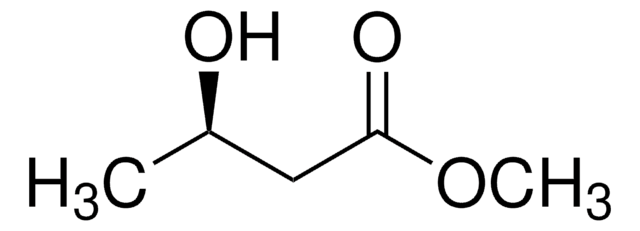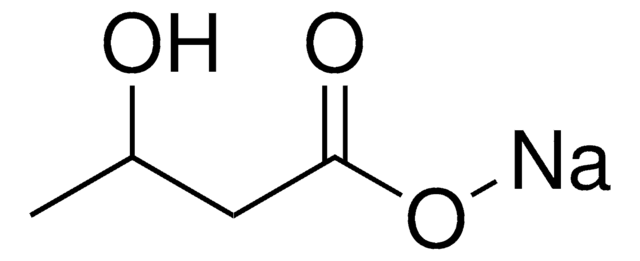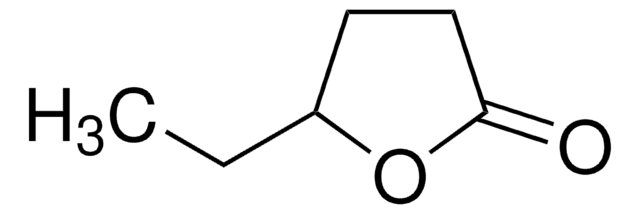W342807
Ethyl 3-hydroxybutyrate
≥97%, FG
Sinônimo(s):
grape butyrate
About This Item
Produtos recomendados
fonte biológica
synthetic
Nível de qualidade
grau
FG
Fragrance grade
Halal
Kosher
Agency
follows IFRA guidelines
conformidade reg.
EU Regulation 1223/2009
EU Regulation 1334/2008 & 178/2002
Ensaio
≥97%
índice de refração
n20/D 1.42 (lit.)
p.e.
170 °C (lit.)
densidade
1.017 g/mL at 25 °C (lit.)
aplicação(ões)
flavors and fragrances
Documentação
see Safety & Documentation for available documents
alérgeno alimentar
no known allergens
alérgeno de fragrância
no known allergens
Organoléptico
grape; green; fruity
cadeia de caracteres SMILES
CCOC(=O)CC(C)O
InChI
1S/C6H12O3/c1-3-9-6(8)4-5(2)7/h5,7H,3-4H2,1-2H3
chave InChI
OMSUIQOIVADKIM-UHFFFAOYSA-N
Procurando produtos similares? Visita Guia de comparação de produtos
Categorias relacionadas
Descrição geral
Aplicação
- Deciphering the immobilization of lipases on hydrophobic wrinkled silica nanoparticles.: This study explores the immobilization of lipases on hydrophobic wrinkled silica nanoparticles, highlighting the potential of these nanoparticles in biocatalysis applications, which can be critical for biochemical synthesis processes involving compounds like Ethyl 3-hydroxybutyrate. (Pota et al., 2024).
- Exploring the Therapeutic Potential of Ethyl 3-Hydroxybutyrate in Alleviating Skeletal Muscle Wasting in Cancer Cachexia.: This research investigates the therapeutic effects of Ethyl 3-hydroxybutyrate in reducing muscle wasting in cancer patients, demonstrating its potential biochemical applications in medical treatments. (Zhou et al., 2023).
- High-Pressure Depolymerization of Poly(lactic acid) (PLA) and Poly(3-hydroxybutyrate) (PHB) Using Bio-Based Solvents: A Way to Produce Alkyl Esters Which Can Be Modified to Polymerizable Monomers.: This study explores the depolymerization of biopolymers using bio-based solvents, resulting in alkyl esters like Ethyl 3-hydroxybutyrate, highlighting its applications in sustainable biochemical processes. (Jašek et al., 2022).
Código de classe de armazenamento
10 - Combustible liquids
Classe de risco de água (WGK)
WGK 3
Ponto de fulgor (°F)
170.6 °F - closed cup
Ponto de fulgor (°C)
77 °C - closed cup
Equipamento de proteção individual
Eyeshields, Gloves, type ABEK (EN14387) respirator filter
Escolha uma das versões mais recentes:
Já possui este produto?
Encontre a documentação dos produtos que você adquiriu recentemente na biblioteca de documentos.
Os clientes também visualizaram
Global Trade Item Number
| SKU | GTIN |
|---|---|
| W342807-10KG | |
| W342807-25KG-K | 4061837546198 |
| W342807-SAMPLE | |
| W342807-100G | |
| W342807-100G-K | 4061837546167 |
| W342807-10KG-K | 4061837536205 |
| W342807-1DRUM-K | |
| W342807-1KG | |
| W342807-1KG-K | 4061837546181 |
| W342807-5KG | |
| W342807-5KG-K | |
| W342807-SAMPLE-K | 4061837536212 |
Nossa equipe de cientistas tem experiência em todas as áreas de pesquisa, incluindo Life Sciences, ciência de materiais, síntese química, cromatografia, química analítica e muitas outras.
Entre em contato com a assistência técnica









